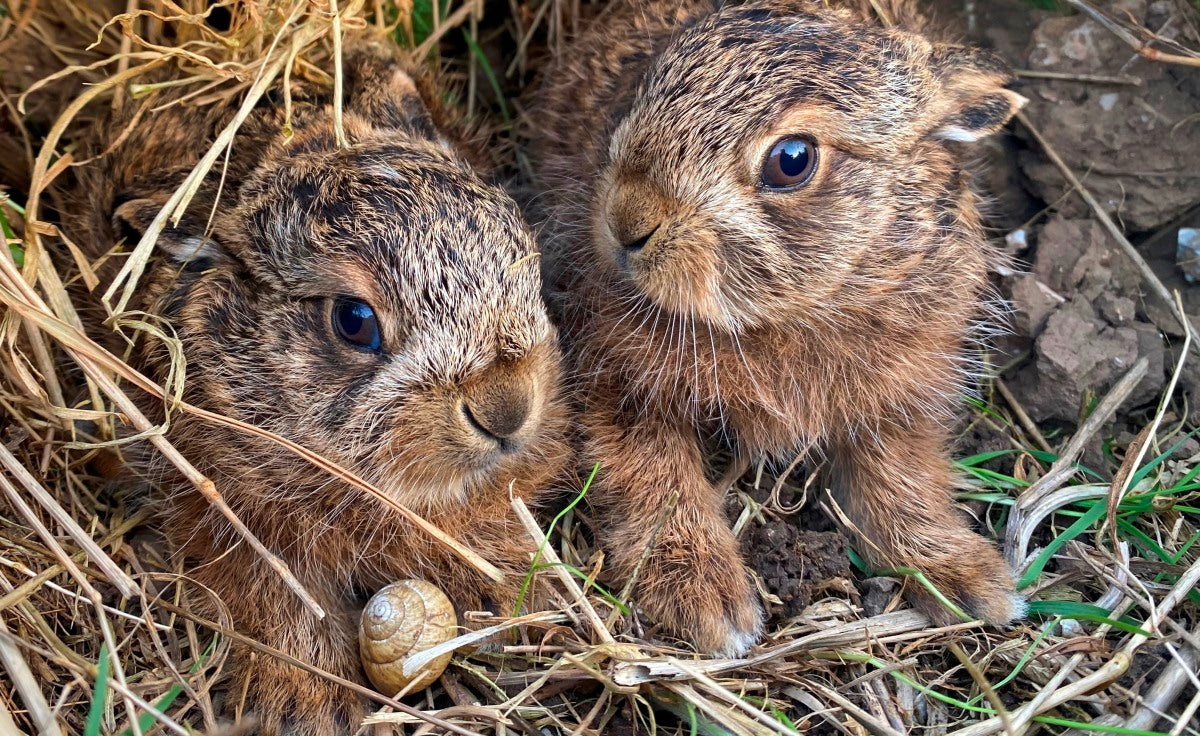I paint directly from my wildlife photographs. This blog post is part of a series featuring the best of my wildlife photography, giving you an opportunity to meet the models in each of my paintings. Each post follows the seasons. The collection below is comprised of photographs taken in spring.
Click here to see a weekly update of paintings these photos have inspired.
Leverets (Lepus Europaeus)

Hares hide their babies, known as leverets, in long grass or under shrubs to keep them safe from predators. If you come across a leveret don’t assume it has been abandoned. It’s mother will return to feed it at night, when it is safe for it to do so.
Golden Plover (Pluvialis Apricaria)
 Golden plovers are on their way from wintering grounds along Britain’s coastal estuaries to their breeding grounds on the moors. Look for them in flocks mixed in with lapwings at this time of year. Their sparkly gold, black and white speckled plumage stands out.
Golden plovers are on their way from wintering grounds along Britain’s coastal estuaries to their breeding grounds on the moors. Look for them in flocks mixed in with lapwings at this time of year. Their sparkly gold, black and white speckled plumage stands out.
King Penguin (Aptenodytes Patagonicus)
 It's World Penguin Day today, April 25th. Many of the king penguins I watched in Antarctica were in South Georgia where the beaches were so crowded with wildlife there were often clashes. Moments after I took this shot, the penguin slapped the elephant seal across the face! Click to read the full story.
It's World Penguin Day today, April 25th. Many of the king penguins I watched in Antarctica were in South Georgia where the beaches were so crowded with wildlife there were often clashes. Moments after I took this shot, the penguin slapped the elephant seal across the face! Click to read the full story.
Kingfisher (Alcedo Atthis)
Kingfishers are courting now. Listen for a high-pitched ‘peep’ along riverbanks and streams. If you hear it, look for a flash of electric blue. And if you see more than one they are likely to be courting so its worth stopping to watch. The male will fish for the female. If you are lucky you can watch as he offers her his catch. Read about kingfishers courtship here.
Cuckoo (Cuculus Canorus)
The sound of a cuckoo call is one of the most welcome signs of spring. But the arrival of this African species can seem sinister. Cuckoos lay their eggs in native bird nests and their chicks then push the host eggs out of the nest. Pictured is a meadow pipet tricked into bringing up a cuckoo chick. Read the story & see the paintings this inspired here.
Leveret (Lepus Europaeus)
 Hares can have up to four leverets at a time and give birth in a shallow hollow, or form, scratched into the earth. The adult female will leave them hidden during the day and only visit once, at dusk, to feed them. It is very rare to witness this secretive behaviour. Read my blog post on filming it.
Hares can have up to four leverets at a time and give birth in a shallow hollow, or form, scratched into the earth. The adult female will leave them hidden during the day and only visit once, at dusk, to feed them. It is very rare to witness this secretive behaviour. Read my blog post on filming it.
Stoat (Mustela Erminea)
 Stoats are extremely agile and will slink through small gaps and into burrows, hollow trunks, banks or thickets to nest. They make these nests out of grass and usually have litters of up to seven. But they keep the locations secret and move them frequently. Click here to read how TV stoat Bandita moved her nest countless times during her filming debut.
Stoats are extremely agile and will slink through small gaps and into burrows, hollow trunks, banks or thickets to nest. They make these nests out of grass and usually have litters of up to seven. But they keep the locations secret and move them frequently. Click here to read how TV stoat Bandita moved her nest countless times during her filming debut.
Wren (Troglodytes Troglodytes)
Today is officially the first day of spring, or spring equinox, and what better way to celebrate than with this photo of a wren perched on cherry blossom and singing its heart out! The wren’s Latin name, Troglodytes, means cave dweller, and as it emerges in full voice from the dark of it feels like a symbol of hope for our times. Click here to see the painting it inspired
Blue Tit (Cyanistes Caeruleus)
The brighter the blue crown on a blue tit’s head, the better mother it makes. According to research by York University, the intensity of colouring on a blue tit crest acts as a sexual signifier to potential mates. Researchers discovered that female birds with duller crowns tended to find chick-rearing more stressful than those with bright blue crowns.
Long Tailed Tit (Aegithalos Caudatus)
Long-tailed tits are one of the first birds to begin building their nests and can be seen in gardens now collecting moss, lichen and cobwebs. The elastic strings of cobwebs are an ingenious touch since they stretch to accommodate the chicks when they grow. Click here to read more

















